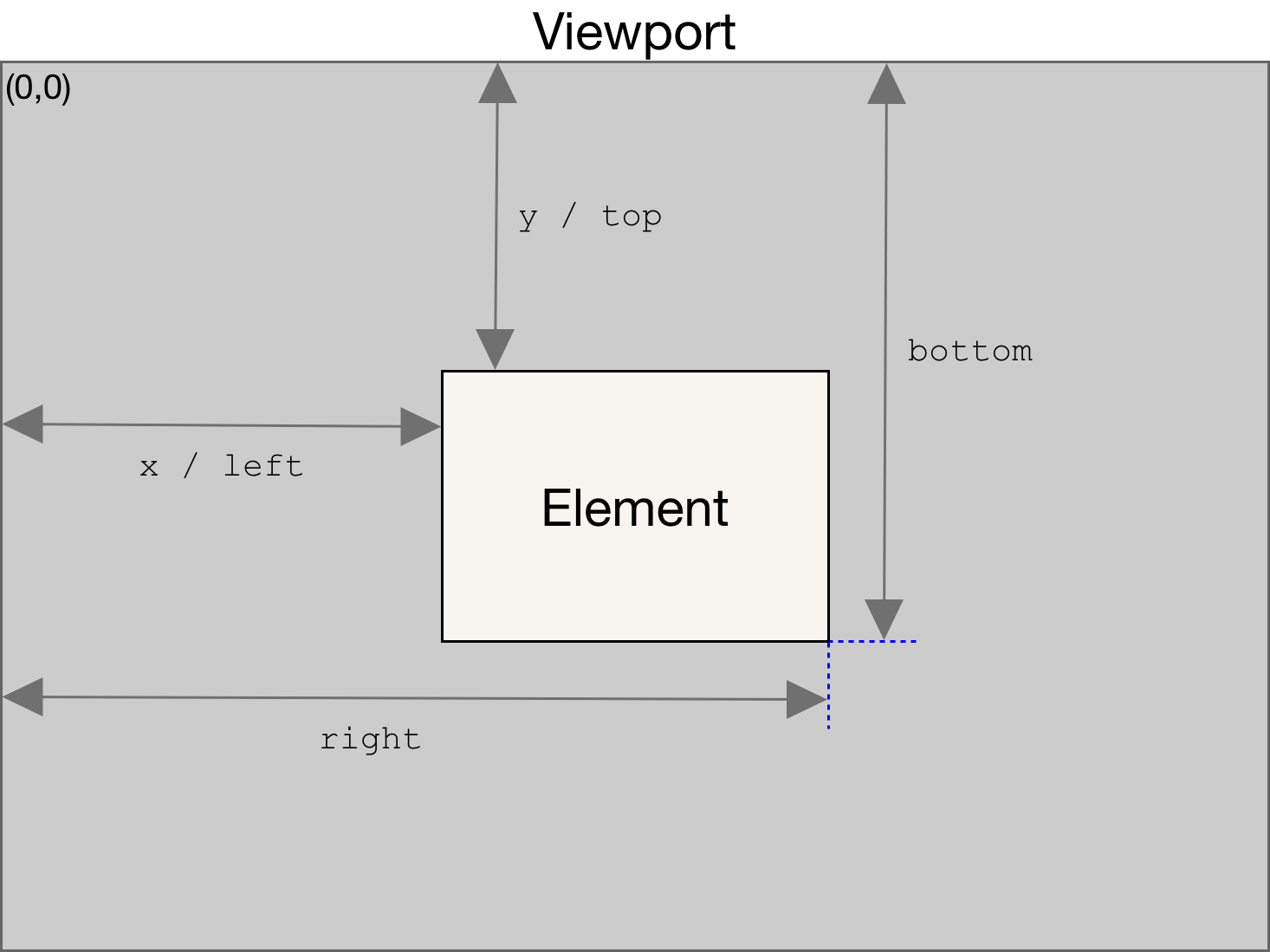Element: getBoundingClientRect() method
Baseline
Widely available
This feature is well established and works across many devices and browser versions. It’s been available across browsers since July 2015.
The Element.getBoundingClientRect() method returns a
DOMRect object providing information about the size of an element and its
position relative to the viewport.
Syntax
getBoundingClientRect()
Parameters
None.
Return value
The returned value is a DOMRect object which is the smallest rectangle
which contains the entire element, including its padding and border-width. The
left, top, right, bottom,
x, y, width, and height properties
describe the position and size of the overall rectangle in pixels. Properties other than
width and height are relative to the top-left of the viewport.

The width and height properties of the DOMRect
object returned by the method include the padding and
border-width, not only the content width/height. In the standard box model,
this would be equal to the width or height property of the
element + padding + border-width. But
if box-sizing: border-box is
set for the element this would be directly equal to its width or
height.
The returned value can be thought of as the union of the rectangles returned by
getClientRects() for the element, i.e., the CSS
border-boxes associated with the element.
Empty border-boxes are completely ignored. If all the element's border-boxes are empty,
then a rectangle is returned with a width and height of zero
and where the top and left are the top-left of the border-box
for the first CSS box (in content order) for the element.
The amount of scrolling that has been done of the viewport area (or any other
scrollable element) is taken into account when computing the bounding rectangle. This
means that the rectangle's boundary edges (top, right,
bottom, left) change their values every time the scrolling
position changes (because their values are relative to the viewport and not absolute).
If you need the bounding rectangle relative to the top-left corner of the document,
just add the current scrolling position to the top and left
properties (these can be obtained using window.scrollY and
window.scrollX) to get a bounding rectangle which is independent from the
current scrolling position.
Examples
Basic
This simple example retrieves the DOMRect object representing the bounding
client rect of a simple <div> element, and prints out its properties
below it.
<div></div>
div {
width: 400px;
height: 200px;
padding: 20px;
margin: 50px auto;
background: purple;
}
let elem = document.querySelector("div");
let rect = elem.getBoundingClientRect();
for (const key in rect) {
if (typeof rect[key] !== "function") {
let para = document.createElement("p");
para.textContent = `${key} : ${rect[key]}`;
document.body.appendChild(para);
}
}
Notice how the width/height are equal to its
width/height + padding.
Also note how the values of x/left,
y/top, right, and bottom are equal
to the absolute distance from the relevant edge of the viewport to that side of the
element, in each case.
Scrolling
This example demonstrates how bounding client rect is changing when document is scrolled.
<div id="example"></div>
<div id="controls"></div>
div#example {
width: 400px;
height: 200px;
padding: 20px;
margin: 50px auto;
background: purple;
}
body {
padding-bottom: 1000px;
}
p {
margin: 0;
}
function update() {
const container = document.getElementById("controls");
const elem = document.getElementById("example");
const rect = elem.getBoundingClientRect();
container.textContent = "";
for (const key in rect) {
if (typeof rect[key] !== "function") {
let para = document.createElement("p");
para.textContent = `${key} : ${rect[key]}`;
container.appendChild(para);
}
}
}
document.addEventListener("scroll", update);
update();
Specifications
| Specification |
|---|
| CSSOM View Module # dom-element-getboundingclientrect |